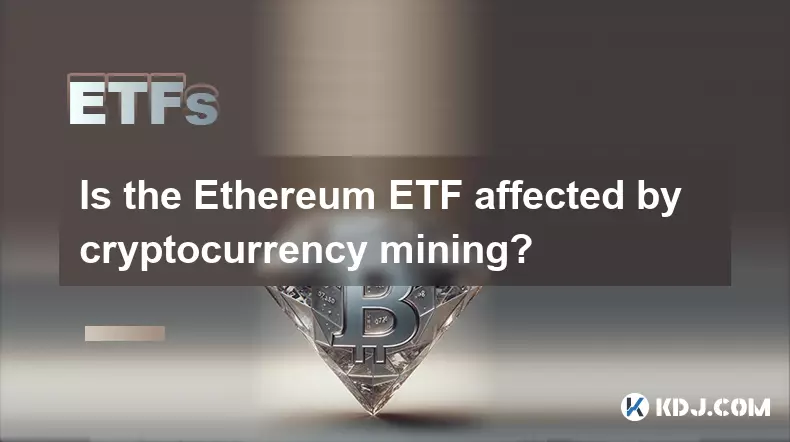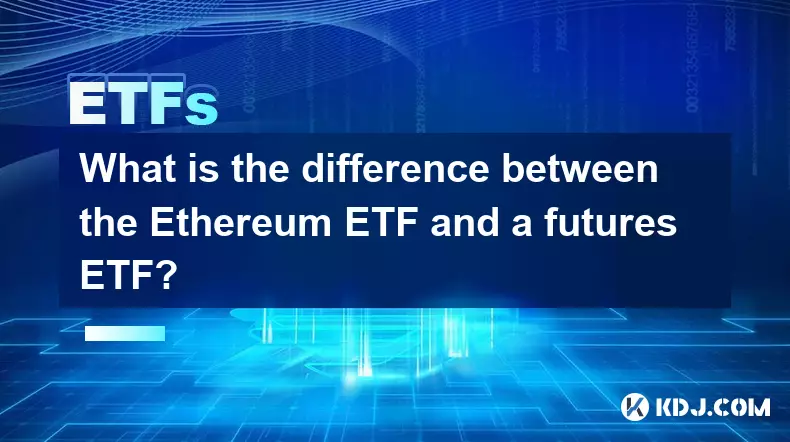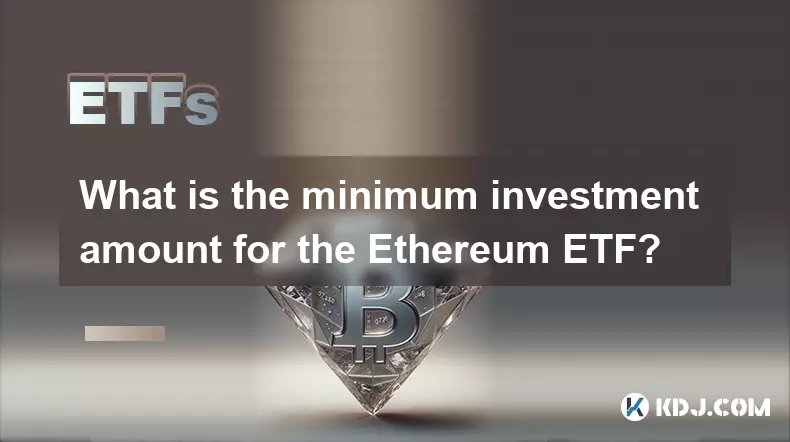-
 bitcoin
bitcoin $109667.069529 USD
-3.03% -
 ethereum
ethereum $3936.685804 USD
-4.07% -
 tether
tether $1.000493 USD
0.01% -
 xrp
xrp $2.771823 USD
-4.74% -
 bnb
bnb $957.805027 USD
-5.34% -
 solana
solana $196.735100 USD
-6.68% -
 usd-coin
usd-coin $0.999727 USD
-0.01% -
 dogecoin
dogecoin $0.227355 USD
-5.12% -
 tron
tron $0.335205 USD
-0.81% -
 cardano
cardano $0.779256 USD
-3.59% -
 ethena-usde
ethena-usde $0.999900 USD
-0.06% -
 hyperliquid
hyperliquid $42.492095 USD
-6.61% -
 chainlink
chainlink $20.501853 USD
-4.34% -
 avalanche
avalanche $28.952606 USD
-11.21% -
 stellar
stellar $0.356038 USD
-3.93%
Is the Ethereum ETF affected by cryptocurrency mining?
Ethereum ETFs track ETH’s price on stock exchanges, with values influenced by demand, regulation, macro trends, and staking yields—not mining, which ended post-Merge.
Sep 23, 2025 at 03:37 pm

Understanding Ethereum ETFs and Their Market Drivers
1. An Ethereum ETF (Exchange-Traded Fund) is a financial product that tracks the price of Ethereum without requiring investors to directly own the cryptocurrency. These funds are traded on traditional stock exchanges and provide exposure to ETH’s price movements through regulated instruments.
- The performance of an Ethereum ETF is primarily influenced by market demand, regulatory developments, macroeconomic trends, and investor sentiment toward digital assets. Since ETFs reflect the spot price of Ethereum, they are not directly tied to the technical processes behind the blockchain, such as transaction validation or consensus mechanisms.
- Unlike mining-based investment products or companies that operate mining rigs, Ethereum ETFs do not generate revenue from computational power or energy consumption. Instead, their value fluctuates based on how the broader market values Ethereum as an asset class.
- Regulatory approval plays a critical role in the launch and trading volume of Ethereum ETFs. Agencies like the SEC assess factors such as market manipulation risks, liquidity, and custody solutions before permitting these funds to list on exchanges.
- Institutional adoption of Ethereum ETFs has grown as more asset managers seek compliant ways to offer crypto exposure. This shift reflects confidence in Ethereum’s long-term utility beyond its original proof-of-work framework.
Mining No Longer Impacts Ethereum’s Consensus Mechanism
1. Ethereum transitioned from a proof-of-work (PoW) system, which relied on mining, to a proof-of-stake (PoS) model during 'The Merge' in September 2022. This fundamental upgrade eliminated the need for energy-intensive mining operations.
- In the current PoS framework, validators secure the network by staking ETH rather than solving cryptographic puzzles. As a result, hash rate, electricity costs, and mining hardware availability no longer affect Ethereum’s operational backbone.
- Since Ethereum ETFs track the native token’s market value and not mining profitability, changes in mining difficulty or miner sell-offs have negligible influence on ETF pricing.
- Any residual mining activity associated with Ethereum refers to forks or legacy chains that did not adopt PoS. These offshoots hold minimal market significance and do not impact the official Ethereum blockchain or its financial derivatives.
- The efficiency gains from PoS—such as reduced environmental impact and faster finality—have strengthened investor perception of Ethereum as a scalable and sustainable platform, indirectly supporting ETF valuations.
Factors That Actually Influence Ethereum ETF Valuation
1. Spot market trading volumes for Ethereum directly affect ETF net asset value (NAV), as fund managers must align holdings with real-time price data from major exchanges.
- Staking yields available on the Ethereum network can make holding ETH more attractive, increasing demand for both the token and ETFs that mirror its performance.
- Smart contract activity, decentralized finance (DeFi) usage, and non-fungible token (NFT) transactions contribute to Ethereum’s ecosystem strength, influencing long-term price expectations.
- Regulatory clarity in key markets like the United States, European Union, and South Korea affects institutional participation in Ethereum ETFs, with favorable rulings often triggering inflows.
- Macroeconomic variables such as interest rates, inflation trends, and risk appetite in global markets shape capital flows into speculative assets, including crypto-linked ETFs.
Frequently Asked Questions
What replaced mining on the Ethereum network?Ethereum now uses a proof-of-stake consensus mechanism where validators are chosen based on the amount of ETH they stake and their commitment to following protocol rules.
Can Ethereum ETFs be affected by GPU shortages or semiconductor supply chains?No. Since Ethereum no longer depends on mining, fluctuations in GPU production or pricing do not impact the underlying asset value tracked by ETFs.
Do Ethereum ETF providers consider energy consumption when valuing the fund?Energy metrics are largely irrelevant post-Merge. Fund managers focus on on-chain analytics, liquidity depth, and compliance frameworks instead of power usage or carbon footprint.
Are there any Ethereum-based financial products linked to mining?Not on the mainnet. Some niche investment vehicles may target historical mining data or alternative PoW blockchains, but these are unrelated to Ethereum ETFs approved by financial regulators.
Disclaimer:info@kdj.com
The information provided is not trading advice. kdj.com does not assume any responsibility for any investments made based on the information provided in this article. Cryptocurrencies are highly volatile and it is highly recommended that you invest with caution after thorough research!
If you believe that the content used on this website infringes your copyright, please contact us immediately (info@kdj.com) and we will delete it promptly.
- Bitwise, Hyperliquid ETF, and Perp DEXs: A New Era in Crypto Trading?
- 2025-09-26 12:25:15
- Ozak AI Price Prediction: Analyst Bull Case for $5 by 2026?
- 2025-09-26 12:25:15
- Bitcoin Price Wobbles: Support Failure and Trader Sentiment in the Mix
- 2025-09-26 12:45:16
- Dogecoin, Memecoins, and the Bull Cycle: Are We Still Barking Up the Right Tree?
- 2025-09-26 12:45:16
- Plasma Ignites DeFi: A New Dawn for Stablecoins and TVL?
- 2025-09-26 12:50:01
- Crypto Tax, Senate Showdown, and Trump Relief: What's the Deal?
- 2025-09-26 12:30:01
Related knowledge

What is the future development prospect of the Ethereum ETF?
Sep 23,2025 at 01:36am
Ethereum ETF and Market Dynamics1. The introduction of an Ethereum ETF has sparked significant interest across the digital asset space. Institutional ...

Is the Ethereum ETF affected by Ethereum gas fees?
Sep 25,2025 at 12:18am
Ethereum ETFs and Their Structural Independence from Gas Fees1. Ethereum Exchange-Traded Funds (ETFs) are financial instruments designed to track the ...

What is the difference between the Ethereum ETF and a futures ETF?
Sep 23,2025 at 06:18am
Bitcoin's Role in Decentralized Finance Evolution1. Bitcoin remains the cornerstone of decentralized finance, serving as a benchmark for value transfe...

Is the Ethereum ETF affected by cryptocurrency mining?
Sep 23,2025 at 03:37pm
Understanding Ethereum ETFs and Their Market Drivers1. An Ethereum ETF (Exchange-Traded Fund) is a financial product that tracks the price of Ethereum...

What is the minimum investment amount for the Ethereum ETF?
Sep 24,2025 at 05:36pm
Understanding Ethereum ETF Investment Thresholds1. The minimum investment amount for an Ethereum ETF can vary significantly depending on the financial...

What are the trading hours for the Ethereum ETF?
Sep 25,2025 at 07:37pm
Understanding Ethereum ETF Trading Hours1. Ethereum ETFs are traded on traditional stock exchanges, which means their availability is bound by the ope...

What is the future development prospect of the Ethereum ETF?
Sep 23,2025 at 01:36am
Ethereum ETF and Market Dynamics1. The introduction of an Ethereum ETF has sparked significant interest across the digital asset space. Institutional ...

Is the Ethereum ETF affected by Ethereum gas fees?
Sep 25,2025 at 12:18am
Ethereum ETFs and Their Structural Independence from Gas Fees1. Ethereum Exchange-Traded Funds (ETFs) are financial instruments designed to track the ...

What is the difference between the Ethereum ETF and a futures ETF?
Sep 23,2025 at 06:18am
Bitcoin's Role in Decentralized Finance Evolution1. Bitcoin remains the cornerstone of decentralized finance, serving as a benchmark for value transfe...

Is the Ethereum ETF affected by cryptocurrency mining?
Sep 23,2025 at 03:37pm
Understanding Ethereum ETFs and Their Market Drivers1. An Ethereum ETF (Exchange-Traded Fund) is a financial product that tracks the price of Ethereum...

What is the minimum investment amount for the Ethereum ETF?
Sep 24,2025 at 05:36pm
Understanding Ethereum ETF Investment Thresholds1. The minimum investment amount for an Ethereum ETF can vary significantly depending on the financial...

What are the trading hours for the Ethereum ETF?
Sep 25,2025 at 07:37pm
Understanding Ethereum ETF Trading Hours1. Ethereum ETFs are traded on traditional stock exchanges, which means their availability is bound by the ope...
See all articles










































































